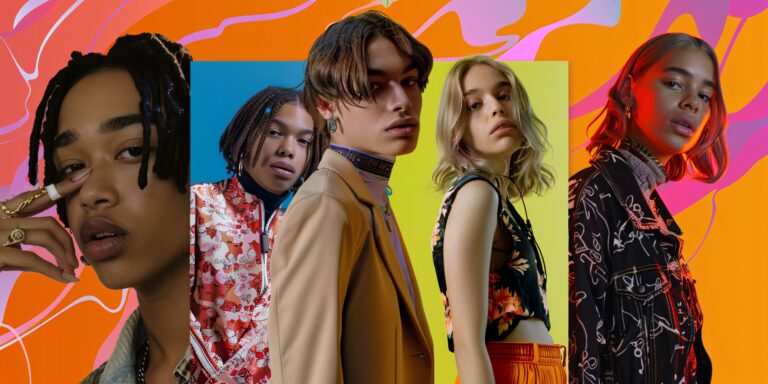Over 100 million images are shared on Instagram each day. This shows how much social media influences the fashion industry. Platforms like Instagram, TikTok, and Pinterest have changed how fashion trends start and spread.
Instagram has nearly 1 billion users every month. It’s a big way for brands to gain trust and be seen by more people. 75% of what we buy is influenced by what we see on social media. This power comes from people such as micro-influencers, with a high engagement rate, and famous celebrities.
Independently, designers can now show their creations worldwide without spending a lot on advertising or having a physical store. With social media, fast fashion, and online shopping combined, fashion has become more open to everyone. The interest in eco-friendly and ethical fashion also shows that online shoppers care about the planet and ethical practices.
Today, social media doesn’t just follow trends; it starts them too. TikTok, for example, can make new styles popular in just a few months. TikTok’s hashtag, #TikTokMadeMeBuyIt, has over 19 billion views, proving its impact. Now, we can all watch fashion shows live, thanks to the internet.
As social media keeps growing, its influence on fashion does too. We’re entering a new time where digital stories affect what we choose to wear. This change redefines what’s considered fashionable.
The Rise of Social Media as a Fashion Powerhouse
In the last few years, social media has become huge in setting fashion trends. Trends change fast, lasting only about six months. Instagram and TikTok are key in this, acting as virtual catwalks. They mix consumers with trendsetters and constantly show new fashion ideas.
Instagram and Visual Engagement
Instagram is known for its beautiful images that offer tons of style ideas. It’s a place where brands and influencers work together. This collaboration creates eye-catching fashion that shifts style norms. Instagram is essential for fashion, making brands’ stories with their photos and videos.
TikTok’s Viral Trends
TikTok is now a top-tier player in fashion, especially with its quick video style that spreads trends fast. The app’s popularity grew a lot during the COVID-19 times. Now, it heavily influences fashion, mostly for Gen Z and young Millenials. TikTok is where new fashion trends get their start, often from fun challenges and influencer partnerships.
Pinterest and Style Inspiration
Pinterest is a giant hub for style influence. It shows a lot of unique fashion, highlighting sustainable choices. This platform mixes popular trends with unique styles. Searches on Pinterest suggest more people are thinking about eco-friendly fashion. It’s a key place for socially conscious shopping methods.
This topic covers how platforms like Instagram and TikTok shape fashion trends a
In today’s digital age, Instagram and TikTok play a big part in setting fashion trends. These apps influence what we wear and how we style ourselves. Since the 2010s, Instagram has been key in shaping what we buy, wear on our faces, and even our choices for plastic surgery.
TikTok is filled with dynamic videos that show off all kinds of fashion, from Balletcore to 2014 soft grunge. It lets users mix their style with others’ ideas in cool ways. TikTok is popular worldwide, owned by over a billion people. Most users are between 16 and 24 years old. They enjoy about 41% of the app’s content.
TikTok is known for making fast, short-lived fashion trends. These trends are made and worn in a hurry to match what’s trending online. This has sped up how quickly the fashion industry can react to new ideas.
The app’s special features, like duet and stitch, bring people together to create new ideas. TikTok’s users get to be very creative within the short videos they can make. This has made TikTok a big part of fast-changing fashion trends.
Both Instagram and TikTok are transforming the way fashion trends begin and spread. Young people are mixing up old fashion with new ideas to create fresh trends. This shows that social media isn’t just watching fashion change. It’s helping to change it.
Influencer Marketing: A New Era of Trendsetting
In our digital times, influencer marketing is changing how fashion trends are set. It has made digital personalities the key players. By doing so, brands engage more closely with their followers. This approach has seen a massive increase in spending, set to hit $24 billion by 2024’s end.
The Role of Influencers in the Digital Age
Thanks to platforms like Instagram and TikTok, influencers have made high-end fashion more accessible. People like Gigi Hadid, with 73 million Instagram fans, show how powerful they can be. A 2023 survey pointed out that Instagram is key for real and engaging fashion posts.
People want to see all kinds of folks represented in fashion, with 60% saying so. This demand highlights the importance of influencers who can share various lives and points of view. It helps build a more united and involved audience.
Case Studies of Successful Influencer Campaigns
Proof that influencer marketing works can be seen in the 56% of 18 to 44 year olds who buy what these influencers promote. This demonstrates how well-targeted campaigns can move people to purchase.
The future looks even brighter for TikTok, with an expected 1.8 billion users by 2024. Its success with short videos makes it ideal for influencer promotions. Plus, the rising budgets for influencer marketing in Europe, aiming for $12.9 billion by 2024, show the field’s growth.
Brands using influencer-driven content are already seeing great results, with over 80% noticing direct sales. Also, more brands are handling their own influencer campaigns. This gives them more control and aligns with a growing use of AI, expected to boost the campaigns’ performance.
Social Media vs. Traditional Fashion Week
The arrival of social media has changed the game for traditional Fashion Week. Now, there’s digital Fashion Week. It’s all about being easy to reach and fast. Platforms like Instagram and TikTok have big user counts and more interaction than traditional media.
For example, TikTok boasts over 1.7 billion users around the world, and the top trends there can be super short-lived. Trends on these digital platforms might only last a couple of weeks. Compare that to traditional media, where trends could stick around longer. The change happens quickly in the digital fashion world.
Thanks to social media, fashion brands are under a lot of pressure to be quick. They have to be faster than what we see at traditional Fashion Week events. This speed means the digital fashion scene is becoming more and more appealing.
The Journal of Fashion Marketing and Management points out how social media changes what people want during Fashion Week. Chanel’s social media success proves this point. It shows how social platforms can either make or break new fashion trends.
Social media makes fashion open to everyone. Consumers can now share their thoughts and join the fashion conversation easily. Platforms like Heuritech help brands understand what’s popular using picture analysis. This gives brands a heads-up on what people want, when they want it.
Recent figures show big growth in shopping through TikTok, with a 553% increase since the start of the pandemic. More than half of TikTok users have bought something through the app. TikTok’s users also tend to support smaller brands more than users on other platforms. This shift shows that Fashion Week is going online, making social media a big player in the fashion world today.
The Role of Algorithms in Fashion Trend Propagation
Algorithms are changing how fashion trends spread. Experts like Vanessa Friedman and Marc Bain say designers now use algorithmic tips for their collections. This new way means social media, not just magazines, guides fashion style. On sites like Instagram, posts with lots of likes are shown more. This shapes what fashion we see and like.
Cornell University’s study on 100 million Instagram photos shows how these algorithms help. They found out what styles and colors people around the world like. This helps brands make clothes that people will want in the future. So, social media helps brands know what their customers want and need. This makes following online trends easier than ever.
But, using algorithms in fashion comes with challenges. Instagram’s rules give it big control over users’ data. This makes some worry about using people’s images without permission. In the U.S., there are laws like the §107 fair use rule. It allows for using data for things like research legally. Yet, using data from sites like Instagram, TikTok, and Pinterest for fashion does raise some ethical concerns.


